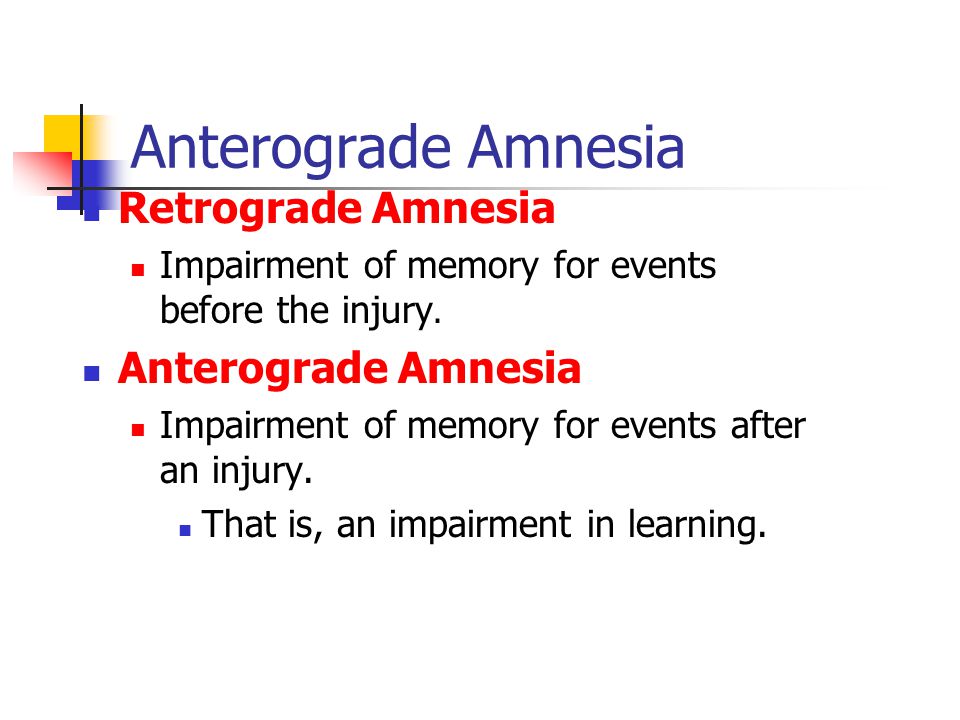Explain the Difference Between Retrograde Amnesia and Anterograde Amnesia.
Therefore anterograde amnesia refers to having difficulties forming memories after amnesia sets in. Anterograde amnesia on the other hand exists when you have the inability to form new memories.

Difference Between Anterograde And Retrograde Amnesia Compare The Difference Between Similar Terms
See the answer Explain the difference between anterograde amnesia and retrograde amnesia Expert Answer In retrograde amnesia the individual is unable to recall past memories whereas in anterograde amnesia.
. When someone who suffers a TBI recovers from a period of loss of consciousness they often have retrograde amnesia that is they cannot remember the accident and the few. Retrograde amnesia is the inability to remember the memories from right before the onset of amnesia What types of memory were impaired in HM and what type of memory was spared. Get an answer for Explain the difference between retrograde and anterograde amnesia and the role of consolidation in memory and find homework help for other Science questions at eNotes.
Explain the difference between retrograde amnesia and anterograde amnesia. Retrograde amnesia is an inability to retrieve info from ones past. Anterograde amnesia is the inability to create new memories.
According to a 2013 study 2 there is an orderly relationship between AA and RA such that patients with. The duration of Clives short-term memory is anywhere between 7 seconds and 30 seconds. Read the full article below for the explanation.
Anterograde amnesia is an inability to form new memories. There are two defined forms of amnesia. Explain the differences between retrograde amnesia anterograde amnesia alcohol.
Retrograde amnesia is the inability to recall past memories while anterograde amnesia is the inability to create new memories. Anterograde amnesia is commonly caused by brain trauma such as a blow to the head. Read the full article below for the explanation.
People with anterograde amnesia dont recall their recent past and are not able to retain any new information. Upon examination of an MRI scan of the patients brain the doctor notices that the patient has damage to the mammillary bodies medial thalamus and frontal lobes. Retrograde amnesia refers to the inability to access memories whereas anterograde amnesia refers to the inability to create new memories.
1 Get Other questions on the subject. Sudden memory loss is more commonly referred to as amnesia. View the full answer Previous question Next question.
Amnesia is a form of memory loss caused by brain damage or diseases. A doctor is diagnosing a patient who reports substantial anterograde and retrograde amnesia. Well perhaps Retrograde Amnesia is an explanation for this.
Retrograde amnesia is the inability to recall past memories while anterograde amnesia is the inability to create new memories. For example a person with retrograde amnesia may forget autobiographical facts. People who suffer from this amnesia can not learn anything new do not remember the names of things or people they know and do not recognize a face.
Correct answer - Explain the difference between retrograde amnesia and anterograde amnesia. Anterograde amnesia and retrograde amnesia Figure 1. Retrograde amnesia is a loss of memories that have been already formed while anterograde amnesia is an inability to form new memories.
With anterograde amnesia you cannot remember new information although you can remember information and events that happened prior to your injury. The major difference between retrograde amnesia and anterograde amnesia is the following. Anterograde amnesia on the other hand involves the lack of ability to form latest memories of any variety after the disorder developed.
There are two common types of amnesia. Retrograde amnesia is the involvement of the memory loss of events people places etc. Retrograde amnesia refers to the loss of information acquired before amnesia while anterograde amnesia AA is an impaired capacity for new learning.
Anterograde amnesia is the loss of the possibility to make new memories after the event that caused the condition such as an injury or illness. The major difference between retrograde amnesia and anterograde amnesia is the following. One form of amnesia called retrograde amnesia is the loss of previously formed memories.
Retrograde amnesia is the loss of memory for information learned before the onset of amnesia and anterograde amnesia is the loss of memory for information learned after the onset of amnesia. Anterograde amnesia is commonly caused by brain trauma such as a blow to the head. There are two defined forms of amnesia.
Retrograde amnesia on the other hand refers to experiencing issues with accessing memories before the onset of amnesia. That were encountered and experienced before the amnesia took its toll on the patient. Retrograde amnesia can be diagnosed through an MRI scan or CT scan blood tests a neurological examination a cognitive test or an electroencephalogram which checks for seizure activity.
The key difference between anterograde and retrograde amnesia is that anterograde amnesia refers to the inability to create new memories while retrograde amnesia refers to the inability to recall past memories. Retrograde amnesia is the inability to recall past memories while anterograde amnesia is the inability to create new memories. The idea that one cannot forget something theyve never learned is called __________.

Anterograde Amnesia Retrograde Amnesia Impairment Of Memory For Events Before The Injury Anterograde Amnesia Impairment Of Memory For Events After An Ppt Download

Types Of Amnesia Definitions Memoryhealthcheck
Mercercognitivepsychology Licensed For Non Commercial Use Only Anterograde Amnesia
Comments
Post a Comment